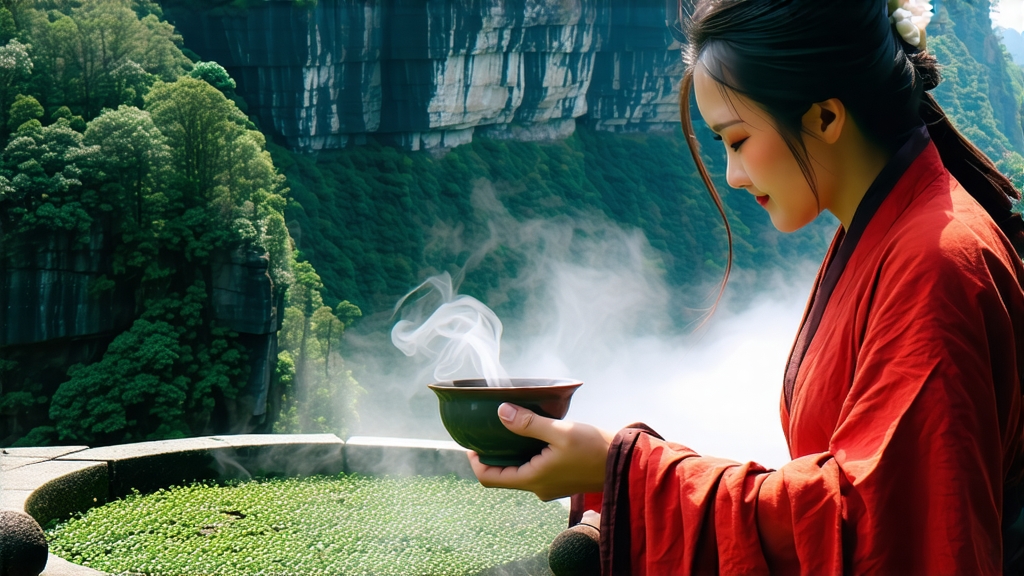
High in the fog-laced crevices of northern Fujian’s Wuyi Mountains, a six-tree grove of gnarled tea bushes clings to a narrow rock ledge known as Jiulong Ke—“Nine-Dragon Gorge.” For more than three centuries these bushes, shielded by mineral-rich cliffs and rinsed by a perpetual cloud drip, have supplied the leaves that Chinese emperors, Ming-dynary scholars, and modern-day billionaires alike have coveted under the name Da Hong Pao, “Big Red Robe.” Today the title belongs not only to those venerable mother trees—now retired under state protection—but to an entire stylistic family of oolong that carries the unmistakable “rock rhyme” (yanyun) of Wuyi’s volcanic terroir. Understanding Da Hong Pao is therefore less about memorizing leaf shape than about tasting the echo of stone in a cup.
Historical legend layers the tea with imperial crimson. The most quoted story tells of a Ming scholar who, en route to the capital examinations, collapsed outside the Wuyi monastery. Monks steeped leaves from the cliff bushes, revived him, and sent him on to earn the highest jinshi degree. To express gratitude the scholar returned in official red robes and draped them over the tea bushes, giving both name and color to the cultivar. Whether myth or marketing, the tale cemented Da Hong Pao’s reputation as tea worthy of court tribute by 1385, and Qing records list it among the “first-grade tribute teas” shipped north in compressed cakes. After 1949 the mother trees were designated national treasure stock; in 2006 picking from them ceased forever, making the 20 g of 1998 vintage that sold for USD 30,800 in 2005 a liquid artifact.
Botanically, Da Hong Pao is a collective, not a clone. The original six trees are genetically distinct; cuttings taken from them in the 1980s produced the so-called “Qi Dan” (pure pedigree) version. Yet most Da Hong Pao on the market is a skillfully balanced blend of three or four Wuyi cultivars—typically Qi Dan, Bei Dou, and the aromatic Tie Luo Han or Rou Gui—designed to recreate the mother-tree profile. Such recipes are guarded like perfumery formulas, and each master roaster keeps parchment notebooks logging fire temperature, humidity, and minute changes in leaf chemistry across the seasons.
Making Da Hong Pao is a three-week dialogue between fire and leaf. Harvest comes in late April when two-and-a-half leaves show a faint purple edge. After a brief outdoor withering under morning sun, the leaves are shaken in bamboo drums to bruise the edges, initiating oxidation that proceeds slowly in cloth-wrapped piles overnight. At 30 % oxidation—when the leaf center is still jade but the rim is rust—the firing begins. Wuyi is one of the last regions to rely on traditional charcoal pits: a waist-deep trench filled with local lychee-wood embers whose steady 120 °C heat perfumes the leaf for eight hours. The tea is then rested for a week, re-fired at a lower 80 °C, rested again, and given a final flash at 100 °C. Each cycle drives moisture from the stem, caramelizes sugars, and fixes the signature “rock flower” aroma that connoisseurs liken to orchid rooted in wet limestone.
To brew Da Hong Pao well, one must borrow the minerality of its birthplace. Begin with spring water whose total dissolved solids sit between 30–80 ppm; anything softer mutes the structure, anything harder dulls the florals. Pre-heat a 120 ml porcelain gaiwan or a thin-walled Yixing zhuni teapot; the clay’s iron oxide amplifies the tea’s resonance. Use 6 g of leaf—roughly one heaping tablespoon—rinsed for three seconds to wake the twisted stripes. The first proper infusion is flash-style: water just off the boil is poured and immediately decanted, yielding a pale apricot liquor that smells of toasted almond and raw honey. Subsequent steeps lengthen by five-second increments; the third and fourth cups are the apex, where roasted cacao melts into a cooling menthol finish that lingers like cave air. A quality Da Hong Pao will deliver seven clear infusions before its bass note fades, leaving only a sweet mineral whisper on the teeth.
Professional cupping follows Wuyi’s “three-bre